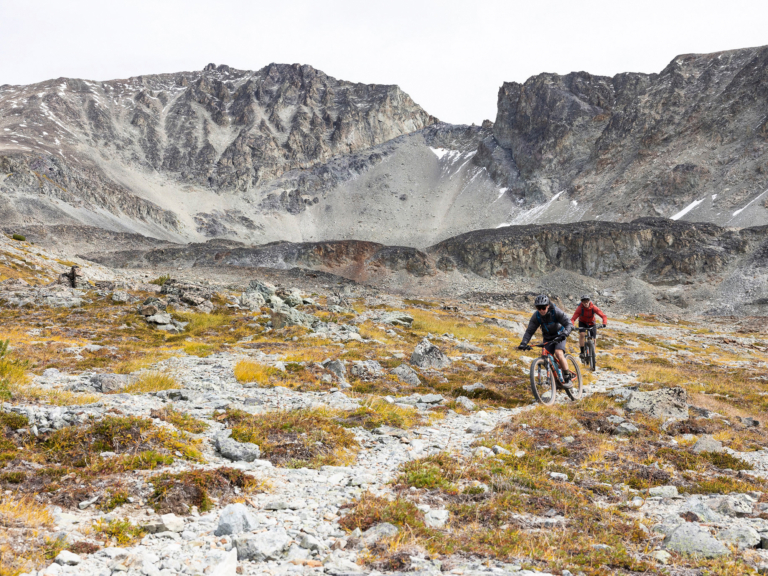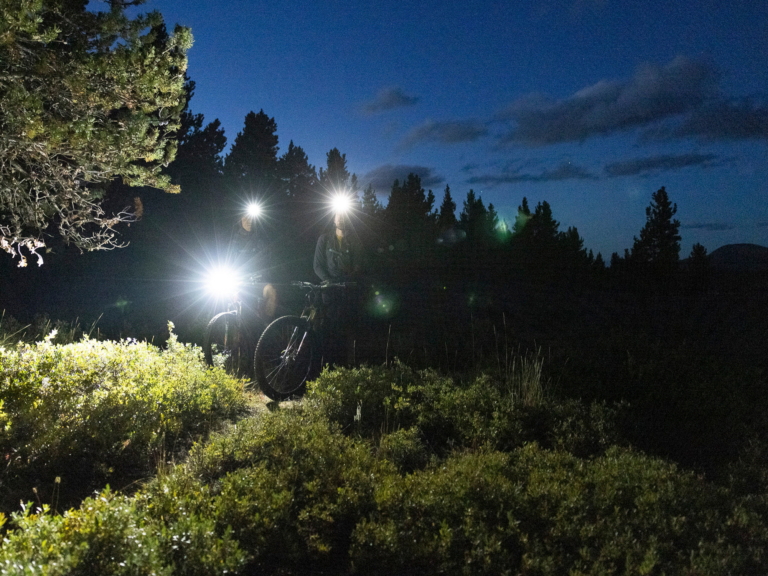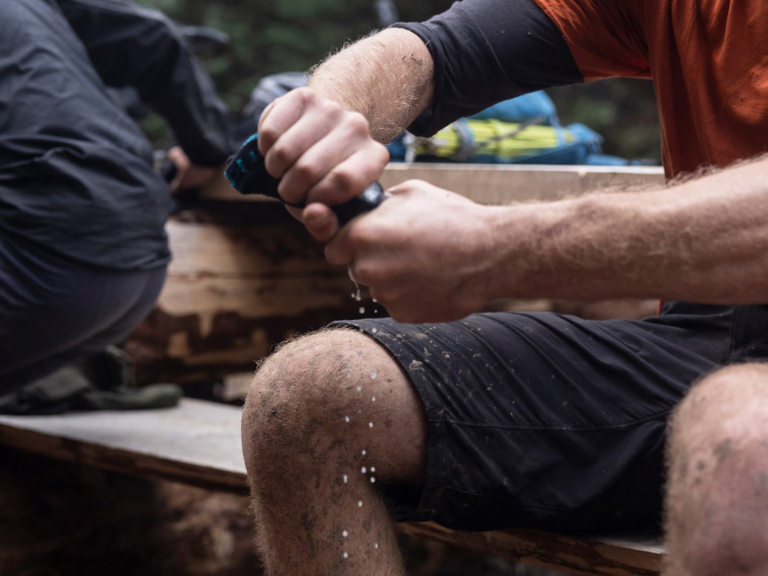Ultralight Foolishness
Delusional optimism and alpine immersion in British Columbia’s South Chilcotin Mountains.
All photos by David Kenworthy. All captions by Will Cadham.
It was nearly 7 p.m. when we finally broke into the alpine on the southwest side of Battlement Ridge, ascending toward Iron Pass. The final climb was brutally steep and riddled with downed trees and trail washouts, forcing us to push our bikes as we clambered over seemingly constant obstacles. Apart from nervous shouts of “Hey, bears!” our group had hardly spoken for the last few hours.
We were in grizzly country, after all.
As we emerged from the treeline, the expansive alpine for which British Columbia’s South Chilcotin Mountains are famous spread out before us, the towering peaks bathed in deep oranges, reddish purples and swathes of slate blue. Our voices were hoarse from a day of yelling and a lack of water—we’d run out several hours before, as each creek we’d passed contained enough silt to clog our water filter.
But it wasn’t thirst or wildlife or fatigue that kept us in sullen silence, growing more tense with each step. It was the collective realization that the sun was near setting, we’d already ridden 18 miles and we were still 20 miles from camp.
It was going to be a long, cold ride home.

The South Chilcotin Mountains are home to over 220 grizzlies, and sightings of the bears are common in the park’s more remote areas. Luckily, the breathtaking views from Elbow Pass—which locals told us has one of the densest bear populations in the park—are a good distraction. Riders: Mark Taylor (left), Will Cadham (right).
Our journey to Iron Pass began in Whistler, British Columbia, at 9:30 a.m. on the first Saturday of September 2021, when Mark Taylor, David Kenworthy and I started the 3.5-hour drive north to the South Chilcotin Mountains Provincial Park (SCMPP).
The trails of the SCMPP and adjacent Big Creek Provincial Park (BCPP) are well known to mountain bikers, and for good reason: Collectively, the two parks encompass one of North America’s largest contiguous networks of subalpine and alpine singletrack, built on a foundation of ancient trails used by the St’át’imc, Tŝilhqot’in and Secwépemc nations and popularized by miners of the Cariboo Gold Rush in the 1860s. The network stretches nearly 180 miles through a wilderness of hulking mountains, glacial lakes and extensive wildlife—including mountain goats, moose, bighorn sheep and over 220 grizzly bears.
Most mountain bikers access the SCMPP and BCPP’s trail network via a float plane taxi service operated by Tyax Adventures, which drops riders on Spruce, Warner or Lorna lakes. The trails connecting the outfitter’s various backcountry operations are both the most popular and well maintained.
The BC Parks’ limited maintenance budget means the rest of the trails are largely looked after by volunteers and conditions can vary wildly from year to year. We wouldn’t be using a float plane for access, and since we’d purposely selected less-frequented trails, the state of much of our route was largely unknown.
But we didn’t care. The purpose of our trip was total immersion in place, six days and five nights of completely human-powered exploration in the two parks’ deeper, more remote regions. With no other destination but that night’s camp, our days were dedicated to mountain biking.
First, however, we had to get there.
Day One – September 4, 2021
We’d originally planned the trip for late October, but an unseasonably cold August storm had temporarily blanketed much of the park with the first snow of the winter and left us scrambling to pull things together a month ahead of schedule. The last thing we wanted was to spend six days riding—or, more likely, hiking—our bikes through snow.
After navigating the infamous Hurley River Forest Service Road we dropped our retrieval vehicle—Mark’s truck, loaded with a carefully curated celebration cooler—at a dusty pullout near Tyaughton Lake, just downhill from where we’d end our ride five days later. Then we all hopped into my venerable 1995 Ford F-150 and continued up the service road for 15 miles to our launch-off point.
We came into our first day with fresh legs, which was good news for multiple reasons: 1) Our bikes were loaded with over 40 pounds of gear, with another 30 pounds on our backs, and 2) only a mile or so of the Little Paradise Creek Trail—our first section of singletrack in the park—was clear enough to ride.

Riders: Mark Taylor (left), Will Cadham (right).

Of the total 5.2 miles we spent on the trail, 4 miles turned out to be an absolute hell of thick alder and deep mud. We soon found ourselves navigating our bikes and 70 pounds of gear through wildly overgrown brush and up steep washouts, all while trying to follow nearly nonexistent fragments of trail. Rider: Mark Taylor.
The slog took far more time and effort than we anticipated, but the thrill of our first singletrack descent was enough to alleviate all that ailed us, making every turn and roller feel more rewarding than the last. Despite setting up camp in the dark, a feast of homemade freeze-dried chili left us beyond satiated.
Day Two – September 5, 2021
Having spent countless hours poring over maps and two prior weekends scouting trails, plus conversations with several Bridge River locals, we felt optimistic—bordering on confident—that we had devised a route prioritizing high-quality singletrack descents and minimizing the laborious hike-a-bikes for which the Chilcotins are infamous.
We did, however, leave a few things up to fortune; two of the six days embraced the concept of “adventure,” and our chances of completing either was based on pure conjecture and a healthy dose of delusional optimism.
Day two was one of these, and the route was undoubtedly ambitious: nearly 10,000 feet of climbing over 38 miles, including multiple mountain passes.

As we struggled up Deer Pass Trail, the first of the day, what started as delusional optimism began to feel more like naive impossibility. The sandy, eroded trail gave little purchase, forcing us to push our heavily loaded bikes upward while we pondered the many miles ahead. Rider: Will Cadham.

From Warner Pass, at the edge of the SCMPP, we could look west down the Honduras Creek drainage and see the Coast Mountains—their icy, jagged profile a noteworthy contrast to the rolling alpine of the Chilcotin Plateau in the eastern parts of the park. The pass also marked the halfway point on the day’s route … a point we should have reached hours earlier, considering we’d already been pedaling for more than half the day. Riders: Will Cadham (left), Mark Taylor (right).

If you spend enough time outdoors with your friends, you’ll eventually find yourself doing something you hadn’t planned to. After over 10 hours in the saddle and more than 30 miles behind us, we reached the bottom of Lorna Pass and flipped on our lights … only 7 miles to go. Riders: Will Cadham (left), Mark Taylor (right).
Day Three – September 6, 2021
If the previous day’s theme was delusional optimism, day three’s was unfamiliar exploration. Graveyard Creek Trail leads into some of BCPP’s northernmost mountainous region, an area none of us had ever explored but which looked promising on the map. It left us caught between excitement and uncertainty: It could be overgrown and barely rideable, or it could be world-class.

After arriving in camp well past dark and downing a silent, late-night meal—followed by some unfortunate bowel irritation—it was easy to sleep past dawn the next morning. But below-freezing temps made getting out of our sleeping bags a challenge of its own. It also gave us a reason to go over the day’s route while we waited for things to warm up (and for our bikes and frozen gear to thaw out). Riders: Will Cadham (left), Mark Taylor (right).

Having not explored BCPP’s northernmost reaches, we dropped into the Graveyard Creek Trail feeling both nervous and eager about what we’d find. Riders: Mark Taylor (left), Will Cadham (right).

Graveyard Valley is sacred ground for the Tŝilhqot’in (Chilcotin) and St’át’imc (Lillooet) nations, who waged tribal wars there for hundreds of years. The last battle was fought in the late 1800s, but numerous marked and unmarked graves are still scattered through the valley. The two nations officially reconciled in 2003, and a memorial plaque now marks the eternal resting place of the fallen warriors. Riders: Mark Taylor (left), Will Cadham (right).

Pine bark beetles had ravaged the forest along the latter half of the Graveyard Creek Trail, and we were thankful for whoever had cut and moved the hundreds of downed trees that had fallen across our path. The great sightlines and fast corners made for an incredible ride—even if you did have to duck around some fire-scarred stumps. Riders: Mark Taylor (left), Will Cadham (right).

It was too dark to see the previous evening, but clear skies revealed stunning views of Tyaughton Peak and nearby glaciers on Mount Warner that feed into Lorna Lake and Big Creek. Riders: Will Cadham (left), Mark Taylor (right).

Depending on the time of year and weather, the numerous creek crossings along Big Creek Trail—and across both parks, in general—can range from ankle deep to extremely dangerous. Luckily, none were too heinous for Mark and the rest of us to wade across (or clamber over) on our way to the evening’s camp on Grant Creek. Rider: Mark Taylor.
Day Four – September 7, 2021
Typically, when you carry your bike on your back for over an hour, you are rewarded with an incredible descent, made sweeter by the sweat equity it took to get there. The climb over Dorrie Ridge, however, didn’t offer such a gravity payoff.
We’d been looking for a way to link Grant Creek Trail with Lorna Lake and decided to follow a mountaineering route over Dorrie Ridge and down the Sluice Creek drainage, with hopes of finding some form of trail. Instead, we found a talus field and spent nearly two hours hiking with our still-hefty bikes slung over our shoulders.
Sometimes you win. Sometimes you walk.

Riders: Mark Taylor (left), Will Cadham (right).
Day Five – September 8, 2021
A good pair of waterproof socks is a key piece of gear when spending multiple days in the backcountry, but when it rains for 36 hours straight, even waterproof boots won’t keep your feet dry. Yet the day didn’t start with a storm; it started with a creek crossing and a punch over Elbow Pass. The rain came a few hours later.

I have never been a big fan of heights or swimming, so scrambling across a downed tree over Grant Creek was my least favorite part of day five’s morning commute. Rider: Will Cadham.

We were all soaked to the bone by the time we reached our camp at Spruce Lake, leaving us to wring out the day’s moisture before crawling into bed. Our efforts proved futile … torrential rain and frigid temperatures that evening and the next day weren’t the parting gift we had hoped for. Rider: Mark Taylor.
Day Six – September 9, 2021
After a week in the mountains, it’s fitting we’d experience a hair-raisingly close call with a grizzly bear on our last day. We’d seen evidence of them the entire trip—prints in the mud, fresh droppings and glowing eyes reflecting back from our headlamps in the dark—but by the time we left camp on our final morning, we had yet to see a bona fide grizzly.
It happened while we were ascending the west side of Windy Pass. The bear was drinking from a creek and must have not heard me approaching; maybe my hoarse cries of “Hey bear!” were drowned out by the rushing water, as my vocal cords were too exhausted for much volume. Whatever the cause, we didn’t notice each other until we were uncomfortably close—less than 50 feet—upon which the bear immediately stood on its hind legs and began sniffing the air. It was well over 7 feet tall and the size of a compact car.
I froze for an instant, then yelled and mustered what little energy I had left to raise my bike over my head. Backing away slowly, I kept my eyes fixed on the magnificent beast and didn’t blink until I was “safely” back in the trees and out of sight … at which point I high-tailed it back down the pass to rejoin the others below.
Taking the “safety in numbers” approach, Dave, Mark and I—flanked by a scrum of strangers we’d picked up while waiting for the bear to leave—headed back toward the treeline. The grizzly, however, was nowhere to be seen.

High Trail is one of the most well known in the South Chilcotins, and it’s especially stunning in the fall when the vibrant yellow and red meadows contrast with stands of dark green conifers. Riders: Mark Taylor (left), Will Cadham (right).

Having consumed all 14 chocolate bars he packed for the trip and still hours from the truck, Mark chased me down the North Cinnabar Trail pleading for a nibble of my emergency-reserve Snickers. Riders: Mark Taylor (left), Will Cadham (right)
When we pulled up to Mark’s truck at the dusty pull-out along Tyaughton Lake Road, we hadn’t completed any fastest known times or Everest challenges, and we definitely weren’t worried about counting calories. We had, however, achieved what we set out for: traversing one of the continent’s most stunning places to ride a mountain bike … and finally reaching our cooler of donuts and beer, a worthy reward for a week of ultralight foolishness.
Things You Should Always Do in Bear Country:
- Stay on maintained trails, and respect trail closures.
- Make noise as you go and make noise often to avoid surprising a bear.
- Keep your eyes on the trail ahead to spot a bear as soon as possible, especially while descending.
- Ride with other people when you can.
- Don’t leave packs or bags containing food unattended, even for a few minutes.
- Never attempt to distract a bear by dropping your pack (or anything else).
- Carry bear spray and know how to use it in an emergency.
- If you encounter a grizzly bear at close range, stay calm, never run away and avoid sudden movements. Be confident, make yourself big and slowly back away.
- Read more about best practices here.


